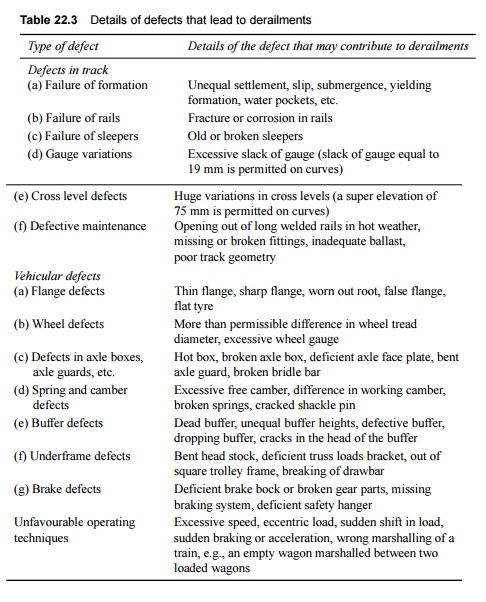Chapter: Civil : Railway Airport Harbour Engineering : Railway Engineering : Railway Accidents and Disaster Management
Derailment and its Causes
Derailment and its Causes
As mentioned earlier, out of all
the various types of railway accidents, derailments are the most common. In the
case of a derailment, an engine or a wagon skids off the railway track due to
one or more relevant factors crossing their safety limits. Derailment may
generally be of two types.
Sudden derailments due to wheel
jumping off the rails This type of derailment is not
characterized by a mounting mark on the rails but by a drop mark on the
sleepers. It occurs when the derailing forces are high enough to force the
wheel to suddenly jump off the rails. The probable causes of this type of
derailment are listed below.
(a) Excessive
speeds, particularly at a curve or turnout
(b) Sudden
shifting of load
(c) Improperly
loaded vehicles
(d) Sudden
variation in drawbar forces caused due to braking or acceleration or improper
train operation
(e) Resonant
rolling, rising, or hunting
(f) Broken
wheels or axles
(g) Failure
of vehicle components
(h) Presence
of some obstruction on the track
(i) Failure
of track components. If both the wheels drop on the inside of the track, it may
be a case of track distortion or gauge expansion.
Gradual derailment due to flange
climbing This type of derailment is caused by the wheel flanges
gradually climbing onto the rails, thus leaving mounting marks on the rail.
Such a derailment occurs when the derailing forces overcome the stabilizing
forces but are not high enough to cause a sudden derailment. In this case, the
unstable condition of the track causes the wheels to climb onto the rail, ride
over it, and finally slip and slide off it. It is difficult to establish the
prima facie cause behind this kind of derailment, and detailed investigations
need to be carried out so as to finally arrive at the exact cause for the same.
The reason for such an accident may be the single or joint effect of the
following factors.
(a) Track
defects
(b) Vehicular
defects
(c) Unfavourable
operating techniques
All these
causes are further elaborated upon in Table 22.3.
Table 22.3 Details of defects that
lead to derailments

1 Derailments on Turnouts
A large number of derailments
occur on turnouts because this is where vehicles change the track they are on.
The reasons for these derailments are generally as follows.
(a) Improper
manipulation of points
(b) Gaping
points
(c) Track
defects
(d) Worn out
wheel flanges
(e) High wing
rail and loose crossing bolts
2 Nadal's Formula for Derailment Analysis
At the time of derailment, when
the wheel flange is in the process of climbing onto the rail, certain forces
act at the part of contact between the rail and the wheel, which lie at
positive angularity to each other as shown in Fig. 22.1.
Nadal's formula for safety against derailment is

where Y is the flange force, Q is the
instantaneous wheel load, R is the normal reaction of the rail, m R is the frictional force acting upwards, m is the coefficient of friction between the wheel flange and
the rail, and b is the
flange angle. Y/Q is known as the derailment coefficient.
Nadal's formula provides an important criterion for the assessment of the
stability of rolling stock. It also has practical use in the investigation of
derailments. Based on Nadal's formula, the factors that contribute to
derailments, whether due to track defects, vehicular defects, or unfavourable
operational techniques, are as follows.
(a) Increase
of flange force Y
(b) Decrease
of instantaneous wheel load Q
(c) Increase
of coefficient of friction between the wheel flange and the rail (m) . This is normally the consequence of a rusted rail, a newly
turned wheel standing on the rail, sharp flanges, etc.
(d) Increase
in positive angle of attack condition ( b )
(e) Increase
in positive eccentricity. This increases primarily due to the slope of the
wheel flange becoming steeper.
(f) Persistent angular running of the axle.
Related Topics